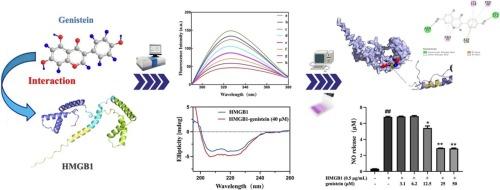通过多光谱和内科学方法探究染料木素与 HMGB1 的相互作用。
IF 4.3
2区 化学
Q1 SPECTROSCOPY
Spectrochimica Acta Part A: Molecular and Biomolecular Spectroscopy
Pub Date : 2024-11-03
DOI:10.1016/j.saa.2024.125385
引用次数: 0
摘要
配体-蛋白质相互作用对蛋白质的功能调控在了解生物过程和确定潜在药物方面起着至关重要的作用。高迁移率基团框 1(HMGB1)作为一种关键的免疫调节蛋白,在无菌性炎症中发挥着举足轻重的作用。染料木素是一种著名的异黄酮化合物,已被证明具有神经保护作用。在这项研究中,我们利用实验和计算方法研究了染料木素与 HMGB1 的相互作用。结果显示,染料木素与 HMGB1 的结合 KD 值为 6.06 × 10-5 M。热力学分析表明,氢键和疏水作用力是结合过程中的主要作用力。此外,染料木素与 HMGB1 之间的相互作用导致了蛋白质发色氨基酸微环境的变化和蛋白质二级结构的微妙改变。分子建模结果表明,Pro95、Pro98 和 Lys154 是染料木素与 HMGB1 结合的主要氨基酸残基。同时,在细胞水平上,观察到染料木素对 HMGB1 诱导的小胶质细胞 NO 释放有抑制作用,抑制率为 42.1%。我们的研究表明,通过与 HMGB1 的相互作用,染料木素可用于治疗神经系统疾病。本文章由计算机程序翻译,如有差异,请以英文原文为准。

Probing the interactions of genistein with HMGB1 through multi-spectroscopic and in-silico approaches
Functional regulation of proteins by ligand–protein interactions plays a crucial role in understanding biological processes and identifying potential drugs. High mobility group box 1 (HMGB1) plays a pivotal role in sterile inflammation as a key immunomodulatory protein. Genistein, a well-known isoflavone compound, has been shown to have neuroprotective effects. In this study, we investigated the genistein-HMGB1 interactions using experimental and computational approaches. Our results revealed that genistein binds to HMGB1 with a KD value of 6.06 × 10−5 M. The addition of genistein significantly quenched the fluorescence of HMGB1. Thermodynamic analyses demonstrated that hydrogen bonds and hydrophobic forces are the primary forces during the binding process. Furthermore, the interaction between genistein and HMGB1 led to changes in the microenvironment of protein chromogenic amino acids and subtle alterations in the protein secondary structure. Molecular modeling results indicate that Pro95, Pro98, and Lys154 are the major amino acid residues for genistein binding to HMGB1. Meanwhile, at the cellular level, an inhibitory effect of genistein on HMGB1-induced NO release from microglia was observed, demonstrating an inhibition rate of 42.1 %. Our studies demonstrated that genistein could be applied in treating neurological diseases through its interaction with HMGB1.
求助全文
通过发布文献求助,成功后即可免费获取论文全文。
去求助
来源期刊
CiteScore
8.40
自引率
11.40%
发文量
1364
审稿时长
40 days
期刊介绍:
Spectrochimica Acta, Part A: Molecular and Biomolecular Spectroscopy (SAA) is an interdisciplinary journal which spans from basic to applied aspects of optical spectroscopy in chemistry, medicine, biology, and materials science.
The journal publishes original scientific papers that feature high-quality spectroscopic data and analysis. From the broad range of optical spectroscopies, the emphasis is on electronic, vibrational or rotational spectra of molecules, rather than on spectroscopy based on magnetic moments.
Criteria for publication in SAA are novelty, uniqueness, and outstanding quality. Routine applications of spectroscopic techniques and computational methods are not appropriate.
Topics of particular interest of Spectrochimica Acta Part A include, but are not limited to:
Spectroscopy and dynamics of bioanalytical, biomedical, environmental, and atmospheric sciences,
Novel experimental techniques or instrumentation for molecular spectroscopy,
Novel theoretical and computational methods,
Novel applications in photochemistry and photobiology,
Novel interpretational approaches as well as advances in data analysis based on electronic or vibrational spectroscopy.

 求助内容:
求助内容: 应助结果提醒方式:
应助结果提醒方式:


